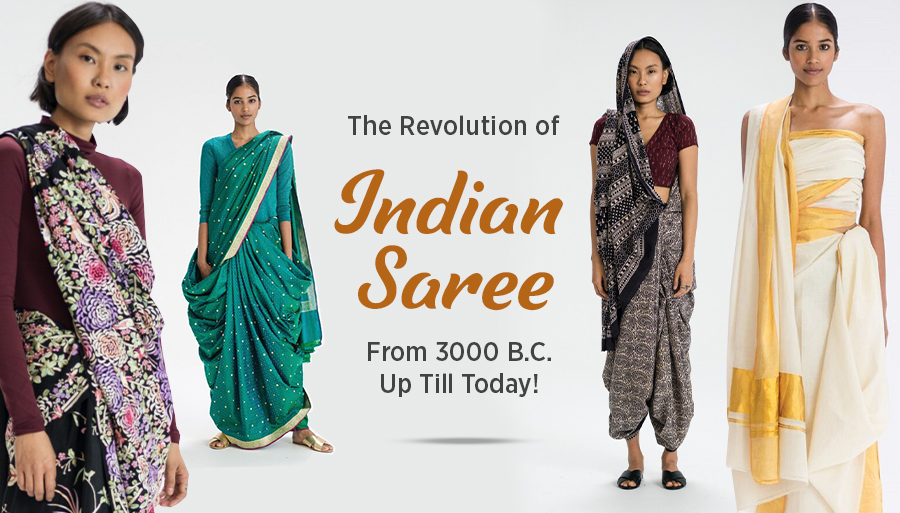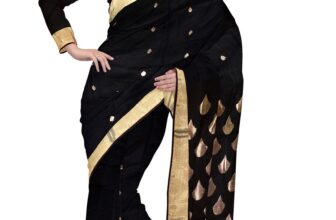
The saree, a symbol of grace and elegance, has been an integral part of Indian culture for centuries. Its timeless appeal lies in its versatility and the way it adapts to changing fashion trends while retaining its traditional essence. This blog explores the evolution of saree fashion, highlighting key trends through the decades that have shaped its journey from a traditional garment to a contemporary fashion statement.
The 1920s-1930s: The Era of Simplicity and Subtlety
In the early 20th century, the saree was predominantly a symbol of modesty and simplicity. Women favored handwoven fabrics like khadi, cotton, and silk, which were often adorned with minimalistic borders and small motifs. This era was heavily influenced by the Indian independence movement led by Mahatma Gandhi, who promoted the use of khadi as a symbol of self-reliance and national pride. The saree was draped in the classic Nivi style, with the pallu (the loose end) elegantly draped over the shoulder.
Key Features:
- Handwoven fabrics
- Minimalistic designs
- Traditional draping styles
The 1940s-1950s: The Golden Age of Bollywood Glamour
The 1940s and 1950s marked the golden age of Bollywood, which had a significant impact on saree fashion. Actresses like Nargis, Madhubala, and Meena Kumari became style icons, and their glamorous sarees captivated the imagination of women across India. Rich fabrics like silk and chiffon gained popularity, often embellished with zari work, sequins, and intricate embroidery. The pallu became more prominent, often styled in creative ways to add a touch of drama.
Key Features:
- Influence of Bollywood
- Rich fabrics and embellishments
- Creative pallu styling
The 1960s: The Advent of Bold Colors and Patterns
The 1960s brought a wave of modernity and experimentation to saree fashion. Influenced by global fashion trends, Indian women began to embrace bold colors, geometric patterns, and psychedelic prints. The introduction of synthetic fabrics like nylon and polyester made sarees more affordable and easier to maintain. This decade also saw the rise of the “butterfly” drape, where the pallu was pleated and spread out like a butterfly’s wings, adding a contemporary twist to the traditional drape.
Key Features:
- Bold colors and patterns
- Synthetic fabrics
- Experimental draping styles
The 1970s: The Era of Feminine Flourishes
The 1970s were characterized by a return to femininity and grace in saree fashion. Floral prints, delicate lace borders, and pastel shades became immensely popular. Actresses like Hema Malini and Mumtaz set new trends with their iconic saree styles, including the famous “Mumtaz saree” drape, which featured a tightly draped lower half and a short, pleated pallu. This era also witnessed the popularity of pre-stitched sarees, which offered convenience without compromising on style.
Key Features:
- Floral prints and lace borders
- Pastel shades
- Iconic draping styles like the “Mumtaz saree”
The 1980s: The Power Dressing Era
The 1980s brought a shift towards power dressing, with sarees reflecting the confidence and assertiveness of women stepping into professional roles. Bold colors, broad borders, and heavy embroidery were the hallmarks of this era. Designer sarees made their debut, with fashion designers like Satya Paul and Ritu Kumar introducing innovative designs and patterns. The blouse became an essential element of the saree ensemble, with bold necklines and statement sleeves adding to the overall look.
Key Features:
- Bold colors and broad borders
- Heavy embroidery
- Designer sarees and statement blouses
The 1990s: The Age of Minimalism
The 1990s saw a shift towards minimalism and understated elegance in saree fashion. Neutral colors, simple silhouettes, and minimal embellishments became the norm. The influence of Bollywood continued, with actresses like Sridevi and Madhuri Dixit popularizing the chiffon saree. The saree blouse evolved further, with halter necks, backless designs, and sleeveless options becoming fashionable. This decade also marked the rise of ready-to-wear sarees, making the saree more accessible to a wider audience.
Key Features:
- Minimalistic designs
- Neutral colors and simple silhouettes
- Evolution of the saree blouse
The 2000s: The Fusion of Tradition and Modernity
The new millennium brought a fusion of traditional and modern elements in saree fashion. Designers like Manish Malhotra and Sabyasachi Mukherjee revolutionized the saree with their contemporary designs and luxurious fabrics. The concept of the “designer saree” became mainstream, with intricate embroidery, sequins, and unconventional draping styles gaining popularity. The saree blouse underwent a transformation, with corset blouses, off-shoulder designs, and embellished patterns becoming the rage.
Key Features:
- Fusion of tradition and modernity
- Designer sarees with luxurious fabrics
- Innovative blouse designs
The 2010s: The Era of Experimentation and Customization
The 2010s were marked by experimentation and customization in saree fashion. Women began to experiment with draping styles, combining the saree with elements like belts, jackets, and crop tops. Sustainable and eco-friendly fabrics gained prominence, reflecting a growing awareness of environmental issues. The concept of mix-and-match became popular, with contrasting blouses and unconventional accessories adding a personalized touch to the saree ensemble.
Key Features:
- Experimental draping styles
- Sustainable fabrics
- Mix-and-match saree ensembles
The 2020s: The Revival of Tradition with a Modern Twist
The current decade is witnessing a revival of traditional sarees with a modern twist. Handloom sarees, regional weaves, and traditional craftsmanship are being celebrated, often paired with contemporary blouses and accessories. The digital age has made it easier to access a wide variety of sarees from different regions, allowing women to explore and appreciate the rich heritage of Indian textiles. Influencers and celebrities on social media continue to inspire new trends, making the saree a global fashion statement.
Key Features:
- Revival of traditional sarees
- Celebration of regional weaves and craftsmanship
- Influence of social media on saree trends
Conclusion
The evolution of saree fashion through the decades reflects the dynamic nature of Indian culture and the ability of this timeless garment to adapt to changing trends while retaining its traditional charm. From the simplicity of the 1920s to the experimentation of the 2020s, the saree continues to be a symbol of elegance, versatility, and cultural pride. Whether you’re drawn to classic styles or modern interpretations, the saree remains a beloved and enduring part of Indian fashion.






